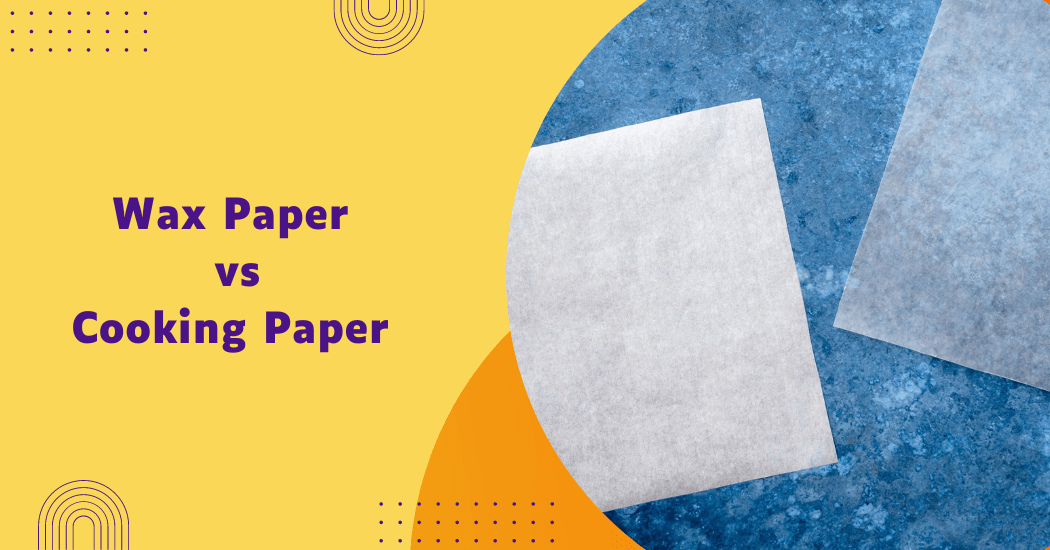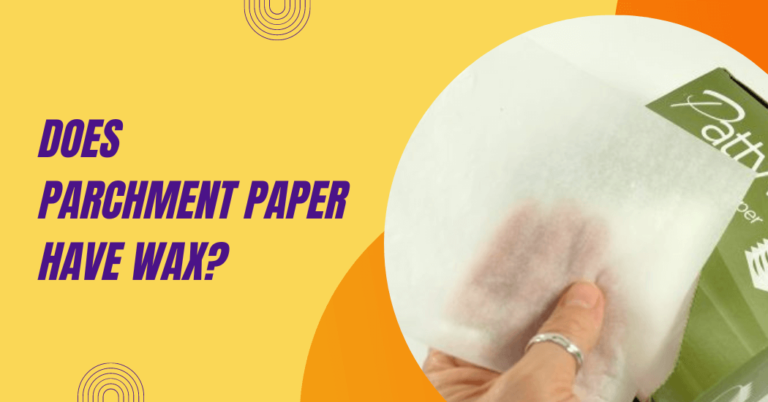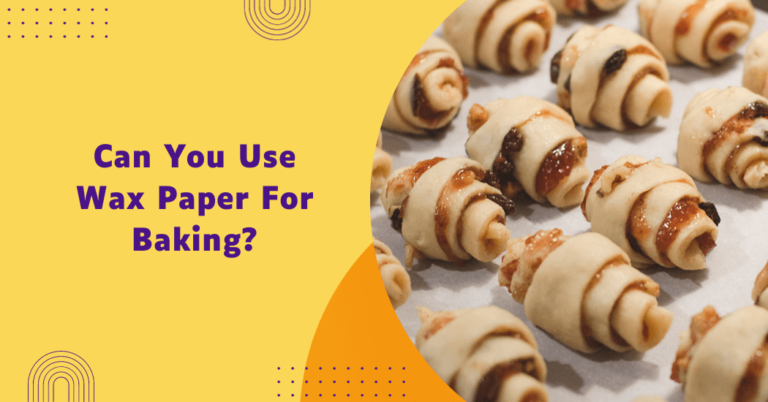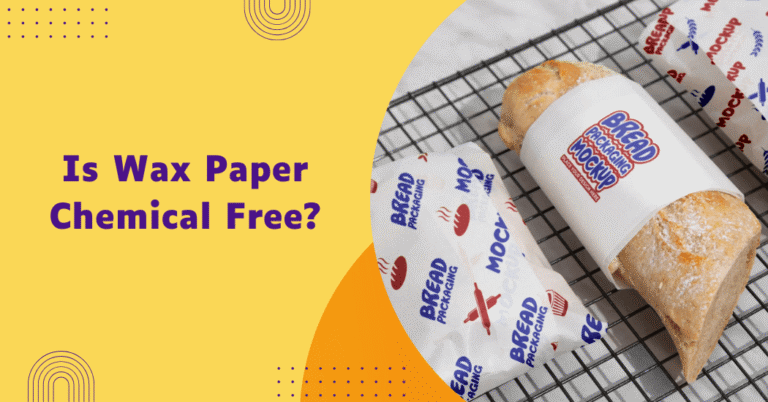What is the difference between wax paper and cooking paper?
Are you often confused about the difference between wax paper and cooking paper? You’re not alone. These two types of papers are commonly used in cooking and baking but many people are unsure about their distinct characteristics and which one is better suited for different purposes.
This lack of clarity can lead to mixing up the papers or using them interchangeably, resulting in undesirable outcomes. But fear not!
In this blog post, we will dive into the details and explore everything you need to know about wax paper versus cooking paper, so you can confidently use them in your kitchen adventures.
Get ready to clear up all your doubts and become a pro at choosing the right paper for your culinary creations!
What is Wax Paper?
Wax paper also known as waxed paper, is a paper that has been coated on both sides with food-safe wax. This coating gives it a non-stick surface along with moisture-resistant properties, making it ideal for food storage since it keeps moisture in or out, depending on the need. However, it’s important to note that wax paper is not heat-resistant.
Therefore, it should not be used in the oven or exposed to any other high-heat environment as the wax could melt, smoke or even transfer to your food. Wax paper works best for tasks like lining countertops to roll out dough, wrapping food for cold storage or separating items in the freezer.
Common uses of wax paper
Wax paper is incredibly versatile in the kitchen and beyond. It’s commonly used for lining drawers or trays to keep them clean when rolling out cookie dough or pie crusts, ensuring a non-stick surface that also aids in easy cleanup.
In addition to food preparation, wax paper is excellent for layering between burgers or homemade cookies before freezing, preventing them from sticking together.
It’s also useful for wrapping up sandwiches or cheese, providing a moisture-resistant barrier that helps to maintain freshness. Outside the kitchen, crafters often turn to wax paper for preserving flowers or as a protective overlay when pressing with a hot iron during creative projects, thanks to its moisture-resistant and non-stick qualities.
Advantages of using wax paper
- Non-stick surface: One of the main advantages of wax paper is its non-stick surface, which makes it ideal for food preparation and storage.
- Moisture-resistant: The wax coating on both sides of the paper makes it moisture-resistant, making it suitable for storing wet or oily foods without getting soggy or sticking together.
- Versatile: Wax paper has a wide range of uses, both in the kitchen and outside, making it a handy tool to have in your home.
- Easy cleanup: Since wax paper prevents food from sticking, it also makes cleaning up after cooking or baking much more manageable.
- Safe for food use: As long as you’re using food-safe wax paper, it’s perfectly safe to use with all types of food, including acidic or oily ones.
- Cost-effective: Wax paper is relatively inexpensive and readily available in most grocery or convenience stores, making it a budget-friendly option for everyday use.
- Can be recycled: Unlike plastic wrap or aluminum foil, wax paper is biodegradable and can be easily recycled, making it an environmentally friendly choice for food storage.
Disadvantages of using wax paper
- Not heat-resistant: Wax paper is not suitable for use in the oven or any high-heat environment, as the wax can melt, smoke or transfer to your food.
- Limited lifespan: Wax paper has a shorter lifespan compared to plastic wrap or aluminum foil and can tear easily if mishandled or exposed to moisture for extended periods.
- Not airtight: While wax paper is moisture-resistant, it’s not entirely airtight, so it may not be the best option for long-term food storage.
- Limited availability: Depending on your location, finding food-safe wax paper can be challenging as it’s not as readily available as plastic wrap or aluminum foil.
What is Cooking Paper?
Cooking paper, commonly known as parchment paper, is a heavy-duty paper that has been treated with an ultra-thin silicone coating, making it non-stick and heat-resistant. This unique combination allows it to withstand high temperatures, which is why it’s an ideal choice for baking and cooking.
Its non-stick properties mean that there’s no need for additional greasing, which not only simplifies the cooking process but also makes for healthier food preparation.
Parchment paper is perfect for lining baking sheets to prevent cookies and pastries from sticking, wrapping fish or poultry for en papillote recipes and can even be used as a disposable piping bag. Unlike wax paper, parchment paper is safe to use in the oven, making it a versatile and indispensable tool for any baker or chef.
Ideal uses for cooking paper in the kitchen
Cooking paper or parchment paper, is a kitchen staple prized for its flexibility and ease of use in various cooking applications. It serves as an excellent liner for baking sheets and cake pans to ensure that baked goods can be easily removed after cooking, with minimal cleanup required.
Parchment paper can also handle the high heat of the oven, making it perfect for roasting vegetables and meats without sticking. Many chefs use it for en papillote cooking, where food is encased in a parchment paper pouch and steamed in its juices, allowing for flavorful and moist dishes.
Further, it is ideal for layering between items like burgers or cutlets before freezing, thus preventing them from sticking together and allowing for easy separation later.
Lastly, cooking paper can be cut to size and shape to create disposable pastry bags or to wrap and mold items such as candy and chocolate, solidifying its status as a versatile kitchen essential.
Advantages of using cooking paper
- Non-toxic and food-safe: Parchment paper is made from natural materials and is free of harmful chemicals, making it safe for use with all types of food.
- Easy cleanup: Just like wax paper, parchment paper makes cleaning up after cooking or baking a breeze as it prevents food from sticking to surfaces.
- Heat-resistant: Parchment paper can withstand high temperatures, making it safe for use in the oven and other cooking methods that involve heat.
- Versatile: Cooking paper has a wide range of uses, from lining baking sheets to creating disposable piping bags, making it an essential tool for any kitchen.
- Compostable: Parchment paper is biodegradable and can be composted, making it an eco-friendly alternative to plastic wrap or aluminum foil.
Disadvantages of using cooking paper
- Not suitable for stovetop use: While parchment paper is safe to use in the oven, it’s not recommended for stovetop cooking as direct heat can cause it to burn or catch fire.
- Can be expensive: Parchment paper can be more costly than other alternatives like wax paper, making it less budget-friendly for everyday use.
- Not airtight: Similar to wax paper, parchment paper is not entirely airtight and may not be the best option for long-term food storage.
- Limited availability of compostable options: While parchment paper is biodegradable, finding compostable or unbleached options may be challenging depending on where you live. Overall, while cooking paper has its limitations and may not be suitable for all types of cooking, it remains a versatile and convenient option for many everyday kitchen tasks.
Wax Paper vs Cooking Paper
| Feature | Wax Paper | Cooking Paper (Parchment) |
|---|---|---|
| Material and composition | Made from food-grade wax (typically paraffin) and paper. The wax is applied to the paper in a thin layer. | Made from unbleached or bleached paper that has been treated with an ultra-thin silicone coating. |
| Heat resistance | Can withstand low heat, typically up to 400 degrees Fahrenheit. | Can withstand high heat, typically up to 450 degrees Fahrenheit. |
| Non-stick properties | Less non-stick compared to cooking paper and may require additional greasing or oil. | Non-stick due to the silicone coating, eliminating the need for additional greasing or oil. |
| Safe for oven use | Not recommended for oven use as the wax coating can melt and cause a fire. | Safe for oven use, making it suitable for various cooking methods including baking and roasting. |
| Versatility | Limited in its use, mainly used as a protective layer for food or to separate items during freezing. | Has a wide range of uses such as lining baking sheets, creating disposable piping bags, steaming food and more. |
| Biodegradable/compostable | Not biodegradable or compostable. | Biodegradable and can be composted, making it an environmentally friendly option. |
| Availability | Easily available at most grocery stores in various sizes and brands. | May be less readily available compared to wax paper, with limited options for unbleached or compostable versions. |
| Cost | More budget-friendly compared to cooking paper. | Can be more expensive than wax paper, depending on the brand and type. |
Which one should you choose?
The choice between wax paper and cooking paper (parchment) largely depends on the specific cooking task at hand.
For oven-based cooking such as baking or roasting, parchment paper is the superior choice due to its high heat resistance and non-stick properties. Its use ensures your food comes off easily after cooking and the sheet can be composted after you’re done, aligning with eco-friendly practices.
On the other hand, for tasks that do not involve heat such as wrapping foods for storage or separating items before freezing, wax paper is a cost-effective and practical option. It provides an adequate non-stick layer and is more budget-friendly. However, given that it is not heat-resistant nor biodegradable, its use is restricted to cold applications.
When considering your purchase, think about your most common cooking needs. If you frequently bake and value easy cleanup, parchment paper is your go-to despite the higher cost. For everyday wrapping and food separation, wax paper might be sufficient.
Ultimately, having both on hand can be beneficial, as each serves a unique purpose in the kitchen. So, make your choice depending on the task at hand and enjoy hassle-free cooking and clean-up!
FAQs – Wax paper vs Cooking paper
Can wax paper and cooking paper be used interchangeably?
Generally, wax paper and cooking paper (parchment) cannot be used interchangeably due to their different heat resistance properties. Wax paper is not suited for oven use as it can melt, whereas parchment is safe for baking and roasting.
Can I put wax paper in the microwave?
Wax paper can typically be used in the microwave for short durations as it does not contain metal like aluminum foil. However, it’s advisable to check the manufacturer’s recommendations before use.
How can I substitute for cooking paper if I don’t have any?
If you don’t have cooking paper, you can use alternatives such as silicone baking mats, aluminum foil coated with a thin layer of cooking oil or simply greasing the baking tray.
Is it safe to reuse cooking paper?
While it’s possible to reuse cooking paper for another batch of baking or roasting, it’s best to discard it if there’s any sign of discoloration or damage from the heat.
Can cooking paper be used for grilling?
While parchment paper is not recommended for direct grilling due to its heat sensitivity, it can be used for indirect grilling or lining the grilling surface to prevent food from sticking.
However, it’s best to check the manufacturer’s recommendations before using parchment paper for grilling. Overall, both wax paper and cooking paper have their respective benefits and limitations,
In Summary
Cooking paper, also known as parchment paper, is a versatile kitchen essential with numerous advantages. It is non-toxic, food-safe, heat-resistant and compostable.
Additionally, it simplifies cleanup after cooking or baking. However, it may not be suitable for stovetop cooking and can be more expensive compared to alternatives like wax paper.
While both wax paper and cooking paper have their advantages and disadvantages, having both in your kitchen arsenal can come in handy depending on the task at hand.
Ultimately, the choice between the two boils down to personal preference and specific cooking needs. So, weigh the pros and cons of each carefully and choose accordingly for a more convenient and enjoyable cooking experience.






